
MicroWeb MWR Wastewater Treatment Packaged Equipment
User Manual
1. Introduction
MicroWeb MWR is a series of wastewater
treatment equipment, which are designed to remove pollutants from wastewater
fast and efficiently combining with the proprietary MicroWeb technology of our
company.
MicroWeb technology uses
encapsulation/flocculation and poly-complexed bridging mechanism to encapsulate,
flocculate, adsorb and stick the particles in the wastewater. Thus, the process
is advanced, effective and highly productive.
MicroWeb MWR can be
widely used in wastewater treatment, especially in industry wastewater. After
the treatment, COD removal rate can be over 90%, and all of COD, BOD, SS, and pH
can reach the discharging standards.
MicroWeb MWR is of the
features: high efficiency, easy operation and management, less investment, less
space occupation, low operating and maintenance costs.
2. MicroWeb MWR model types
MicroWeb MWR model types are shown as below:
MWR-01-OSM
That is: MWR-Number-
(letter1)(letter2)(letter3)
Where:
Number --- The capacity of MWR; in this example it is
1ton/hour.
Letter1--- O stands for oil removal; N stands for no oil removal.
Letter2--- F stands for adsorption filter; S stands for HESS settling tank; D
stands for DAF system; P stands for press filter.
Letter3 --- A stands for automatic pH system; M stands for manual pH system.
MWR model types are listed in table 1. Please contact us if you
have any other requirements of model types.
Table1. MWR Model Types
| Model type
| Equipment
| Capacity
| Use range
| Estimated size (m)
|
|
MWR-01-OFA
|
1.Oil removal
2.MicroWeb reactor
3.Adsorption filter
4.Chemical addition system
5.Automatic pH system |
1±0.2t/h |
Suitable for W.W. with high oil content, water
qualities vary large, and SS/COD less than 0.4. |
3.0(L)x3.0(W)x2.0(H) |
| MWR-05-OFA |
5±1t/h |
4.0(L)x4.0(W)x2.7(H) |
| MWR-15-OFA |
15±3t/h |
4.0(L)x4.0(W)x2.7(H) |
| MWR-25-OFA |
25±5t/h |
6.0(L)x4.0(W)x2.7(H) |
| MWR-50-OFA |
50±10t/h |
6.0(L)x6.0(W)x2.7(H) |
| MWR-01-NFM |
1.MicroWeb reactor
2.Adsorption filter
3.Chemical addition system |
1±0.2t/h |
Suitable for W.W. with low oil content, water
qualities vary slightly, and SS/COD less than 0.4. |
3.0(L)x1.8(W)x2.0(H) |
| MWR-05-NFM |
5±1t/h |
4.0(L)x1.8(w)x2.7(H) |
| MWR-15-NFM |
15±3t/h |
4.0(L)x1.8(w)x2.7(H) |
| MWR-25-NFM |
25±5t/h |
4.0(L)x4.0(w)x2.7(H) |
| MWR-50-NFM |
50±10t/h |
6.0(L)x4.0(w)x2.7(H) |
| MWR-01-NFA |
1.MicroWeb reactor
2.Adsorption filter
3.Chemical addition system
4.Automatic pH system |
1±0.2t/h |
Suitable for W.W. with low oil content, water
qualities vary large, and SS/COD less than 0.4. |
3.0(L)x1.8(W)x2.0(H) |
| MWR-05-NFA |
5±1t/h |
4.0(L)x1.8(W)x2.7(H) |
| MWR-15-NFA |
15±3t/h |
4.0(L)x1.8(W)x2.7(H) |
| MWR-25-NFA |
25±5t/h |
4.0(L)x4.0(W)x2.7(H) |
| MWR-50-NFA |
50±10t/h |
6.0(L)x4.0(W)x2.7(H) |
| MWR-01-OFM |
1.Oil removal2.MicroWeb reactor3.Adsorption
filter4.Chemical addition system |
1±0.2t/h |
Suitable for W.W. with high oil content, water
qualities vary slightly, and SS/COD less than 0.4. |
3.0(L)x3.0(w)x2.0(H) |
| MWR-05-OFM |
5±1t/h |
4.0(L)x4.0(w)x2.7(H) |
| MWR-15-OFM |
15±3t/h |
4.0(L)x4.0(w)x2.7(H) |
| MWR-25-OFM |
25±5t/h |
6.0(L)x4.0(w)x2.7(H) |
| MWR-50-OFM |
50±10t/h |
6.0(L)x6.0(w)x2.7(H) |
| MWR-01-OSA |
1.Oil removal
2.MicroWeb reactor
3.HESS system
4.Chemical addition system
5.Automatic pH system |
1±0.2t/h |
Suitable for W.W. with high oil content, water
qualities vary large, and SS/COD more than 0.4. |
1.8(L)x1.5(W)x2.0(H) |
| MWR-05-OSA |
5±1t/h |
3.0(L)x2.5(W)x2.8(H) |
| MWR-15-OSA |
15±3t/h |
6.0(L)x4.0(W)x2.0(H) |
| MWR-25-OSA |
25±5t/h |
8.0(L)x6.0(W)x2.2(H) |
| MWR-50-OSA |
50±10t/h |
15(L)x10(W)x2.5(H) |
| MWR-01-OSM |
1.Oil removal
2.MicroWeb reactor
3.HESS system
4.Chemical addition system |
1±0.2t/h |
Suitable for W.W. with high oil content, water
qualities vary slightly, and SS/COD more than 0.4. |
1.8(L)x1.5(W)x2.0(H) |
| MWR-05-OSM |
5±1t/h |
3.0(L)x2.5(W)x2.8(H) |
| MWR-15-OSM |
15±3t/h |
6.0(L)x4.0(W)x2.0(H) |
| MWR-25-OSM |
25±5t/h |
8.0(L)x6.0(W)x2.2(H) |
| MWR-50-OSM |
50±10t/h |
15(L)x10(W)x2.5(H) |
| MWR-01-NSA |
1.MicroWeb reactor
2.HESS system
3.Chemical addition system
4.Automatic pH system |
1±0.2t/h |
Suitable for W.W. with low oil content, water
qualities vary large, and SS/COD more than 0.4. |
1.8(L)x1.5(W)x2.0(H) |
| MWR-05-NSA |
5±1t/h |
3.0(L)x2.5(W)x2.8(H) |
| MWR-15-NSA |
15±3t/h |
6.0(L)x4.0(W)x2.0(H) |
| MWR-25-NSA |
25±5t/h |
8.0(L)x6.0(W)x2.2(H) |
| MWR-50-NSA |
50±10t/h |
15(L)x10(W)x2.5(H) |
| MWR-01-NSM |
1.MicroWeb reactor
2.HESS system
3.Chemical addition system |
1±0.2t/h |
Suitable for W.W. with low oil content, water
qualities vary large, and SS/COD more than 0.4. |
1.8(L)x1.5(W)x2.0(H) |
| MWR-05-NSM |
5±1t/h |
4.0(L)x3.0(W)x2.8(H) |
| MWR-15-NSM |
15±3t/h |
7.0(L)x6.0(W)x2.8(H) |
| MWR-25-NSM |
25±5t/h |
12(L)x10(W)x2.8(H) |
| MWR-50-NSM |
50±10t/h |
25(L)x20(W)x3.0(H) |
| MWR-01-ODA |
1.Oil removal
2.MicroWeb reactor
3.DAF system
4.Chemical addition system
5.Automatic pH system |
1±0.2t/h |
Suitable for W.W. with high oil content, water
qualities vary large, and light specific gravity sludge. |
3.5(L)x3.0(W)x2.1(H) |
| MWR-05-ODA |
5±1t/h |
4.5(L)x4.5(W)x2.5(H) |
| MWR-15-ODA |
15±3t/h |
6.0(L)x6.0(W)x2.8(H) |
| MWR-25-ODA |
25±5t/h |
9.0(L)x6.0(W)x2.8(H) |
| MWR-50-ODA |
50±10t/h |
12(L)x6(W)x2.8(H) |
| MWR-01-NDA |
1.MicroWeb reactor
2.DAF system
3.Chemical addition system
4.Automatic pH system |
1±0.2t/h |
Suitable for W.W. with low oil content, water
qualities vary slightly, and light specific gravity sludge. |
3.5(L)x1.5(W)x2.1(H) |
| MWR-05-NDA |
5±1t/h |
4.5(L)x2.5(W)x2.5(H) |
| MWR-15-NDA |
15±3t/h |
6.0(L)x3.0(W)x2.8(H) |
| MWR-25-NDA |
25±5t/h |
6.0(L)x6.0(W)x2.8(H) |
| MWR-50-NDA |
50±10t/h |
10(L)x6.0(W)x2.8(H) |
| MWR-01-ODM |
1.Oil removal
2.MicroWeb reactor
3.DAF system
4.Chemical addition system |
1±0.2t/h |
Suitable for W.W. with high oil content, water
qualities vary slightly, and light specific gravity sludge. |
3.5(L)x3.0(W)x2.1(H) |
| MWR-05-ODM |
5±1t/h |
4.5(L)x4.5(W)x2.5(H) |
| MWR-15-ODM |
15±3t/h |
6.0(L)x6.0(W)x2.8(H) |
| MWR-25-ODM |
25±5t/h |
9.0(L)x6.0(W)x2.8(H) |
| MWR-50-ODM |
50±10t/h |
12(L)x6(W)x2.8(H) |
| MWR-01-NDM |
1.MicroWeb reactor
2.DAF system
3.Chemical addition system |
1±0.2t/h |
Suitable for W.W. with low oil content, water
qualities vary slightly, and light specific gravity sludge. |
3.5(L)x1.5(W)x2.1(H) |
| MWR-05-NDM |
5±1t/h |
4.5(L)x2.5(W)x2.5(H) |
| MWR-15-NDM |
15±3t/h |
6.0(L)x3.0(W)x2.8(H) |
| MWR-25-NDM |
25±5t/h |
6.0(L)x6.0(W)x2.8(H) |
| MWR-50-NDM |
50±10t/h |
10(L)x6.0(W)x2.8(H) |
| MWR-01-OPA |
1.Oil removal
2.MicroWeb reactor
3.Press filter
4.Chemical addition system
5.Automatic pH system |
1±0.2t/h |
Suitable for W.W. with high oil
content, water qualities vary large and high solid content. |
3.5(L)x1.5(W)x1.5(H) |
| MWR-02-OPA |
2±0.4t/h |
3.5(L)x1.5(W)x1.5(H) |
|
|
|
|
|
|
|
|
|
| MWR-01-NPA |
1.MicroWeb reactor
2.Press filter
3.Chemical addition system
4.Automatic pH system |
1±0.2t/h |
Suitable for W.W. with low oil
content, water qualities vary large and high solid content. |
1.5(L)x1.5(W)x1.5(H) |
| MWR-02-NPA |
2±0.4t/h |
2.0(L)x1.5(W)x1.5(H) |
|
|
|
|
|
|
|
|
|
| MWR-01-OPM |
1.Oil removal
2.MicroWeb reactor
3.Press filter
4.Chemical addition system. |
1±0.2t/h |
Suitable for W.W. with high oil
content, water qualities vary large and high solid content. |
3.5(L)x1.5(W)x1.5(H) |
| MWR-02-OPM |
2±0.4t/h |
3.5(L)x1.5(W)x1.5(H) |
|
|
|
|
|
|
|
|
|
| MWR-01-NPM |
1.MicroWeb reactor
2.Press filter
3.Chemical addition system |
1±0.2t/h |
Suitable for W.W. with low oil
content, water qualities vary large and high solid content. |
1.5(L)x1.5(W)x1.5(H) |
| MWR-02-NPM |
2±0.4t/h |
2.0(L)x1.5(W)x1.5(H) |
|
|
|
|
|
|
|
|
|
3.The principle of MicroWeb MWR and the description of equipment
As showed in the flowchart, MWR consists of three or four
parts:
(1) Oil removal (used for high oil content wastewater) (2) MicroWeb reactor (3)
Chemical adding system (4) Adsorption filter, or HESS settling tank, or
Dissolved-air flotation system, or Press Filter.
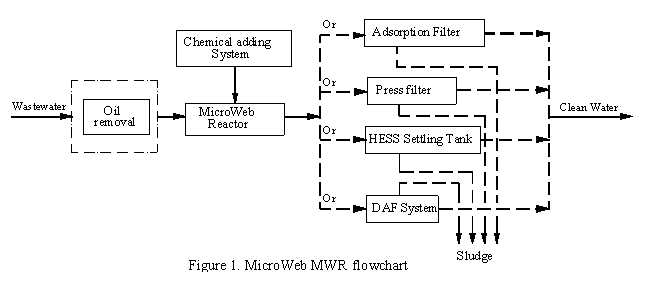
3-1. Oil removal
For the high oil content wastewater, the oil removal is
necessary. The sketch of oil removal is shown as figure 2.
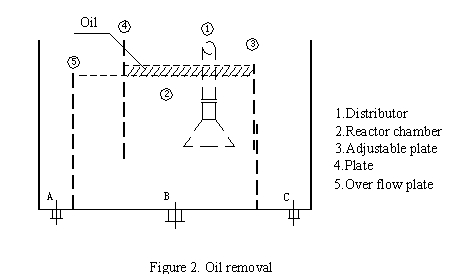
The wastewater is inputted in oil removal with the
distributor 1. When accumulated to the designed height, the oil is discharged by
lower the plate 3. The treated water flow out from port B. Plate 4 is used to
block oil, plate 5 is used to keep the stable of water level. Over flow water is
returned back to collecting tank through port A.
3-2. MicroWeb reactor
The sketch is shown as below.
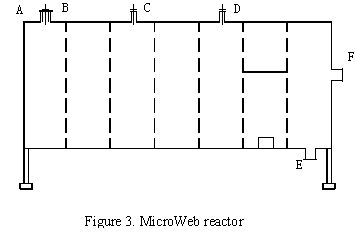
The wastewater and chemicals are mixed completely to finish
MicroWeb procedure while they go through the channels. Port A is the input of
wastewater. The chemicals PAC, Ca(OH)2 and PolyWeb P30 are added from port B, C,
D separately. Port E is the output of treated water, and port F is the over flow
output.
3-3. Adsorption filter
The sketch is as figure 4.
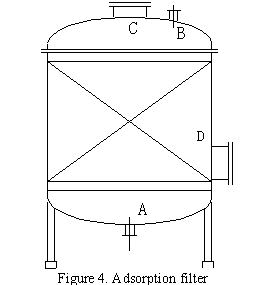
Adsorption filter is chosen for the wastewater with the
ratio of SS/COD less than 0.4. After MicroWeb reaction, the mixture of water and
sludge go into the adsorption filter from bottom port A. The sludge are adsorbed
and filtered by the fillers, then the clean water go out through the top port B.
When the gap of the pressures that between the input and output is equals or
bigger than 1.2kg/cm2, the system needs to be back washed. The clean water rinse
from the top B and the sludge flow out from port A to the filter bag.
3-4. HESS settling tank
The sketch is as figure 5.
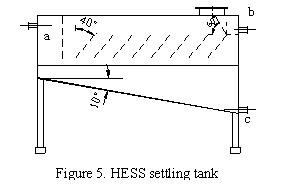
When the ratio of SS/COD is more than 0.4, HESS settling
tank is a good choice for sludge separation. The mixture of water and sludge are
separated in the tank with staying for about 30 minutes. The clean water is
discharged through pipe b after filtered with a 400-mush-filter. The sludge flow
into the filter bag through port c.
3-5. DAF system
The sketch is as figure 6.
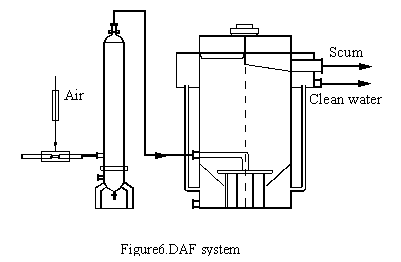
DAF system is effective to treat the sludge separation that
of light specific gravity. The mixture of water and sludge are pumped into the
mixer, and then rush in the high efficiency jet device, where the ejected fluid
meet with the fine air bobs that come from the compressor and form a 3-D spin
fluid. When distributed in the separator, the sludge go up to the surface and
are scraped into the scum channel, and then are discharged to the sludge tank,
while the clean water is guided to the output with the link pipes.
3-6. Press filter
The sketch is shown as figure 7.
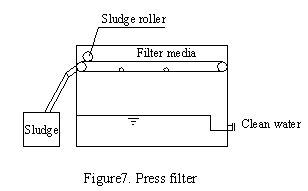
Press filter is powerful to the sludge-separation when the
ratio of SS/COD is big, therefore, there is large quantity sludge formed in the
treatment. The mixture of water and sludge falls onto the filter media where it
dewaters by gravity. The sludge laden filter media then passes under a roller
that squeezes out any excess water. The sludge then falls into a disposal
container. The clean water settles in the settling tank and then it is
discharged.
4. Preparation of chemicals
Chemical preparation and dosage control
(1) PAC
PAC can be used directly when it is solution. If PAC is in solid state, it needs
to be diluted to solution of 30% concentration.
(2) Ca (OH)2
Ca (OH)2 solution is used in the concentration of 10%. To add Ca (OH)2 is to
adjust the pH of the wastewater reacted with PAC, and keep pH at the range of
7.0~7.5.
(3) P30
In preparing P30 standard solution, disperse P30 solid power in 2000 times its
own weight of water. The P30 powder should be introduced gradually into clean
water (15~45oC) and dispersed for approx 0.5~1 hr. at a speed of between 20~80
RPM until a uniform dispersion is obtained. Normally the solution can be stored
for 3 days. Two tanks for diluting are recommended, so they can be alternatively
operated.
The dosage of P30 should be 1.2~1.5ppm; that is, adding 2.4L~3L P30 solution
(0.05%) into one ton wastewater.
5. MicroWeb MWR operations
1. MWR-XX-OSM
The sketch is shown as figure 8
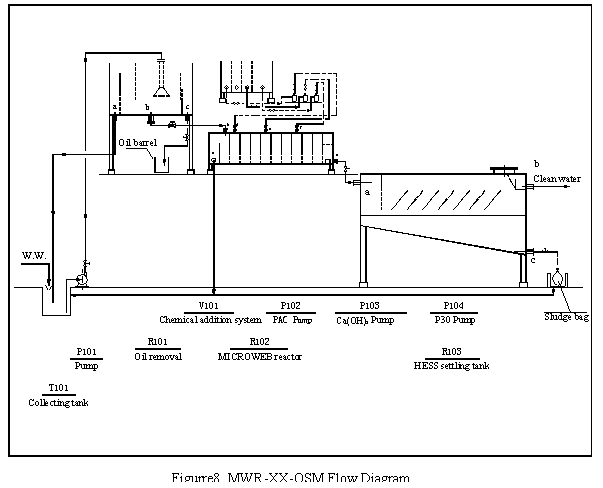
(1) Oil removal process
Adjusting the height of plate 3, make it higher than the over flow plate 5
about 10 mm. Turn off the output valve and start pump P101. When there is water
flow over the over flow plate 5, turn on the output valve, and ensure there is
water flow over at all time. When the thickness of oil is about 30mm, lower the
adjustable plate 3 to let the oil out.
(2) MicroWeb reactor process
While the wastewater flow into the reactor, start the pumps P102, P103, and
P104 to make the chemicals mix and react with the wastewater. To keep a stable
capacity, the first channel should keep having over flow at any time.
(3) Settling and filter process
When the mixture of sludge and water which comes from reactor goes into the
HESS settling tank, the sludge settle down to the bottom and the clean water
separated to the upper layer. The sludge is discharged from bottom output valve.
Filtered with a 400-mush-filter, the clean water flow out through output b.
2. MWR-XX-OSA
Except with the automatic pH system, all the other processes are the same as
MWR-XX-OSM. That is, the system installed a probe to detect pH in the channel
where P30 is added. Whenever the figure of pH is out off the range, the system
will adjust the quantity of Ca (OH)2 automatically to keep the pH at the range
6-9.
3. MWR-XX-NSA
Except without oil removal, all the other processes are the same as
MWR-XX-OSA.
4. MWR-XX-NSM
Except without oil removal, all the other processes are the same as
MWR-XX-OSM.
5. MWR-XX-NFM
The sketch is shown as figure 9.
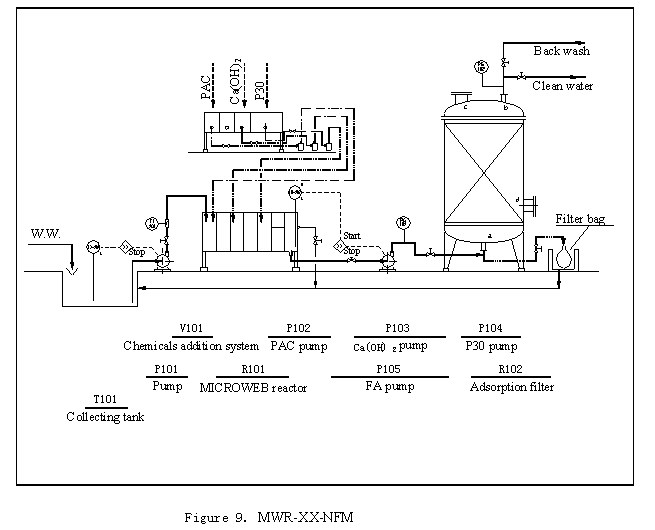
(1) MicroWeb reactor process
While the wastewater flow into the reactor, start the pump P102, P103, and
P104 to make the chemicals mix and react with the wastewater. To keep a stable
capacity, the first channel should keep having over flow at any time.
(2) Adsorption filter process
The pump P105 will start automatically when the detector LX-102 signals that
the water level in the last channel of MicroWeb reactor is higher than designed
height. After pumped into the adsorption filter, the sludge are filtered and
adsorbed by the fillers. Clean water is out off the top.
When the gap of the pressures between the input and output is equals or bigger
than 1.2kg/cm2, the system needs to be back washed. Close the valves of P102,
P103, P104, and P105. The clean water is rinsed from the top, and the sludge
flow out from the bottom pipe to the filter bag.
6. MWR-XX-NFA
Except with the automatic pH system, all the other processes are the same as
MWR-XX-NFM. That is, the system installed a probe to detect pH in the channel
where P30 is added. Whenever the figure of pH is out off the range, the system
will adjust the quantity of Ca (OH)2 automatically to keep the pH within the
range of 6-9.
7. MWR-XX-OFM
Except with oil removal, all the other processes are the same as MWR-XX-NFM.
8. MWR-XX-OFA
Except with oil removal, all the other processes are the same as MWR-XX-NFA.
9. MWR-XX-NDA
The sketch is shown as figure 10.
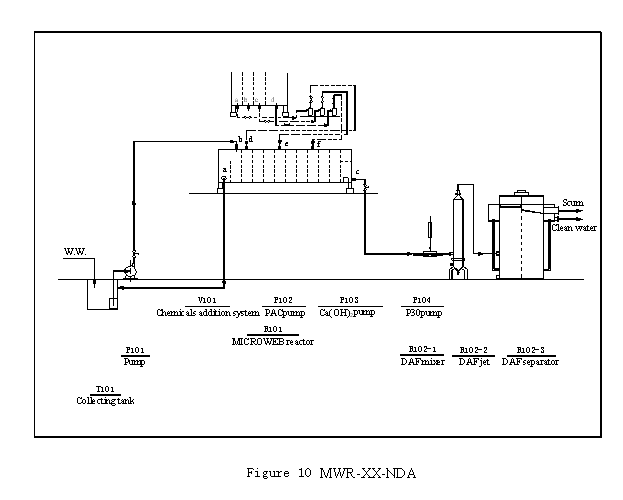
(1) MicroWeb reactor process
While the wastewater flow into the reactor, start the pump P102, P103, and
P104 to make the chemicals mix and react with the wastewater. To keep a stable
capacity, the first channel should keep having over flow at any time.
(2) Sludge separation process
DAF system consists of three parts, mixer, jet, and separator. When the
detector LX-102 sends signal out, the pump P105 will start automatically to pump
the mixture of sludge and water into the DAF system.
(3) The automatic system of pH
The system installed a probe to detect pH in the channel where P30 is added.
Whenever the figure of pH is out off the range, the system will adjust the
quantity of Ca (OH)2 to make the pH keep at the 6-9.
10. MWR-XX-NDM
Except without automatic pH system, all the other processes are the same as
MWR-XX-NDA.
11. MWR-XX-ODA
Except with oil removal, all the other processes are the same as MWR-XX-NDA.
12. MWR-XX-ODM
Except with oil removal, all the other processes are the same as MWR-XX-NDM.
13. MWR-XX-NPM
The sketch is shown as figure 11.
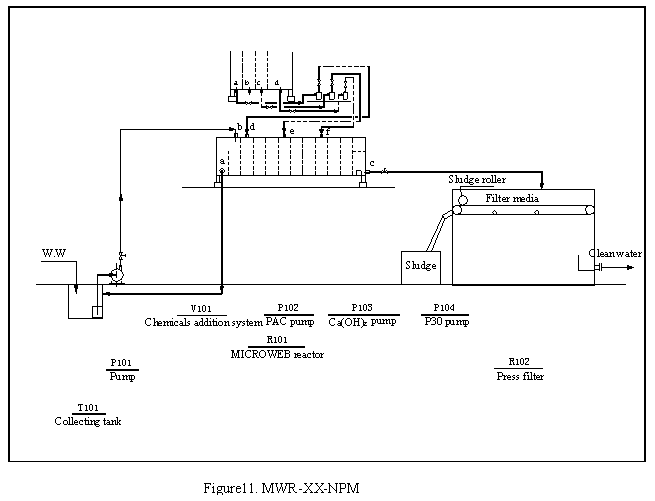
(1) MicroWeb reactor process
While the wastewater flow into the reactor, start the pump P102, P103, and
P104 to make the chemicals mix and reaction with the wastewater. To keep a
stable capacity, the first channel should keep having over flow at any time.
(2) Sludge separation process
The mixture of water and sludge falls onto the filter media where it dewaters
by gravity. The sludge laden filter media then passes under a roller that
squeezes out any excess water. The sludge then falls into a disposal container.
The clean water settles in the settling tank and then it is discharged.
14. MWR-XX-NPA
Except with the automatic pH system, all the other processes are the same as
MWR-XX-NFM. That is, the system installed a probe to detect pH in the channel
where P30 is added. Whenever the figure of pH is out off the range, the system
will adjust the quantity of Ca (OH)2 to keep pH at 6~9.
15. MWR-XX-OPM
Except with oil removal, all the other processes are the same as MWR-XX-NPM.
16. MWR-XX-OPA
Except with oil removal, all the other processes are the same as MWR-XX-NPA.
6. MicroWeb MWR maintenance
6-1. Oil removal
Check and clean the distributor periodically to keep it work well.
6-2. MicroWeb reactor
The main joints and valves of the MicroWeb EPB should be checked and cleaned
periodically to prevent block up. When not in operation, these parts need to be
cleaned up and get ready for the reuse.
6-3. Adsorption filter
When the gap of the pressures that between the input and output is equals or
bigger than 1.2kg/cm2, the system needs to be back washed. . When not in
operation, take off the fillers from hand hole and clean them up in case the
sludge concrete on the fillers.
6-4. HESS settling tank
The 400-mush-filter needs to be cleaned or changed regularly.
6-5. DAF system
a. Mixer
When not in operation, it needs to be cleaned thoroughly.
b. Jet
Clean up the jet device thoroughly before stop operation to ensure the sludge
would not block the distributing plate.
c. Separator
Check the moving parts of the scum skimmer periodically.
6-6. Press filter
After used for a period of time the filter media could be blocked, backwash it
use the designed system. Replace the filter media at the condition that the
media can not use again.
© 2002, RE Water Solutions Inc.
Updated October 18, 2002










